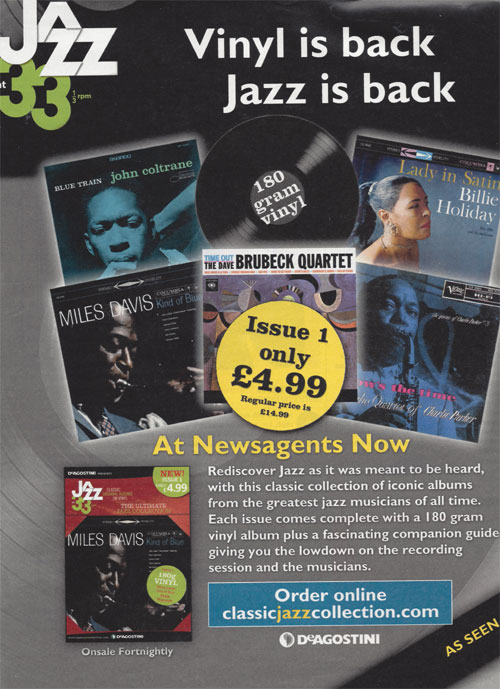The Ultimate Jazz Collection: Considering the Law of Unintended Consequences
So what are we to make of De Agostini’s latest offering, sporting the catchy title Jazz At 33 1/3 RPM with the arresting subtitle, "Vinyl is back. Jazz is back"? Promising to build into "The Ultimate Jazz Collection," the fortnightly series consists of a seminal jazz album pressed on 180-gram vinyl and accompanied by a magazine that discusses the history of the musicians and recording itself. The first issue goes out at £4.99, with regular issues costing £14.99 each -- not exactly bargain-basement pricing but actually on a par with, or cheaper than, pricing for 180-gram reissues. The first three titles are Miles Davis's Kind of Blue (of course), John Coltrane's Blue Train and Billie Holiday's Lady In Satin, with Charlie Parker's Now’s The Time and Dave Brubeck's Time Out to follow, which is a pretty stellar lineup by any standards. The problem is that any pitch such as this raises as many questions as it answers, especially for devotees of the subject matter. There are no details about the catalog as a whole and no details about the source of the records -- who pressed them or the pressing process -- but then I’d take a wild stab that dedicated audiophiles really aren’t the target audience here. However, with national advertising campaigns on UK TV and in the weekend color supplements of national broadsheet newspapers (notably, the liberal-leaning Guardian), it’s safe to say that De Agostini are doing vinyl’s public profile no harm at all. What’s even better news is that assuming De Agostini’s customers are actually doing what it says on the tin, "Rediscover[ing] jazz as it was meant to be heard," most of them are going to need something to hear it on. Not withstanding De Agostini’s generous offer to flog them a USB-ready Pro-Ject turntable, that means they’ll be shopping for record players and at least some of them might just find their way into genuine audio dealers, and that’s exactly the kind of opportunity this industry can ill afford to ignore. I’m trying hard to find out more about the source of
De Agostini’s discs, if only to satisfy my own curiosity. Unlikely I know, but this
might just turn out to be a genuine bargain. Leaving that particular pipe dream aside,
whatever else this partwork jazz catalog might be, it’s almost certainly a massive
potential can of worms, an invitation to not only rediscover jazz, but vinyl too -- and by
association high-end audio and all that that entails. |

 think it is fair to say
that partworks -- those magazine series that, over the course of months, give you enough
free pieces to construct a model aircraft carrier/space shuttle/girlfriend -- don’t
have the best of reputations, despite their enduring popularity and undoubted profit
potential. You only need to consider the cover price and the national TV and newspaper ad
campaigns to understand that the guys behind these publications are not messing about.
There is serious money to be made and that means serious numbers when it comes to sales.
De Agostini (not to be confused with the high-end audio manufacturer with a very similar
name) is the granddaddy of modern partwork producers. I say "modern" because
this is a tradition that goes way back, beyond the likes of Charles Dickens or
subscription encyclopedias, but the "If you build it, then you’ll also have a
considerable stack of not inexpensive magazines" model really got started in the
1950s.
think it is fair to say
that partworks -- those magazine series that, over the course of months, give you enough
free pieces to construct a model aircraft carrier/space shuttle/girlfriend -- don’t
have the best of reputations, despite their enduring popularity and undoubted profit
potential. You only need to consider the cover price and the national TV and newspaper ad
campaigns to understand that the guys behind these publications are not messing about.
There is serious money to be made and that means serious numbers when it comes to sales.
De Agostini (not to be confused with the high-end audio manufacturer with a very similar
name) is the granddaddy of modern partwork producers. I say "modern" because
this is a tradition that goes way back, beyond the likes of Charles Dickens or
subscription encyclopedias, but the "If you build it, then you’ll also have a
considerable stack of not inexpensive magazines" model really got started in the
1950s.